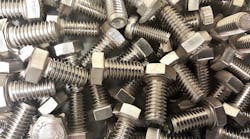The little unsung heroes. They’re tough, durable, and can stand up to extreme environments. They have to, otherwise, who will? What will keep together all we hold dear?
Those reasons are why aviation and aerospace fasteners are made to rigid, uncompromising standards. That’s also why they undergo an inspection process on a level akin to a surgeon about to perform an operation before becoming available on the market. Otherwise you risk losing expensive equipment, machinery, or even lives for that matter.
These fasteners undergo strict regulations for several reasons, but before we get into those, let’s take a look at some of the more common hardware types and what makes them aviation/aerospace-grade. Screws, nuts, bolts, pins, and collars (and a ton of specialty types) are the most common fasteners that can be found in any mechanic’s toolbox; the difference between these and those found at Home Depot is quality. They need to handle the rigors of high-stress, pressures, and temperature extremes without risk of failure.
This fastener “family” is from a leading aviation fastener manufacturer known as PCC Fasteners.
Most often these fasteners will be constructed using several different materials, each with their benefits and applications. For example, aluminum is a great lightweight material for the aerospace industry with blind rivets widely used in fuselage skins. However, to stand up to the stress and flex that skin undergoes, they need to be cold-head-formed rather than machined.
Stainless and alloy steels are commonly found in aerospace-grade bolts, as they can hold up to significant stress and heat depending on the type. Series 300 Corrosion Resistant Stainless Steel, for example, is great for humid environments, but can’t handle high temperatures as alloy-based steels. On the other hand, alloys tend to degrade faster than stainless.
Titanium and super-alloys (A286, MP35N, Monel, etc.) can handle most any environment, including space, as it has the strength of steel hardware and is lightweight like aluminum. The SR-71 Blackbird is a prime example of aerospace engineering that used titanium-alloy fasteners extensively throughout its design.
No matter the material or type of fastener, aviation/aerospace manufacturers employ extensive quality-control measures for their fasteners to maintain standards set by the U.S. government, which includes everything from the selection and testing of raw materials to using special imaging systems for making sure their hardware measures up.
Beware of Counterfeits
As I mentioned before, there are reasons for the strict regulation of these fasteners and fittings. Believe it or not, it all boils down to counterfeit hardware, which has been flooding the market since the 70s and has continued into the 21st century. The FAA terms this bogus hardware as “unapproved parts” and began an investigation into the use of faulty fasteners that started with the crash of Norwegian Flight 394 in 1989.
Partnair’s Convair CV-580 (Flight 394) crashed due to three counterfeit bolts and faulty APU mount. (Image credit: Gary Watt- Wikipedia)
After a two-year investigation into the downing of Flight 394, the NARI (Norwegian Aeronautical Research Institute) determined that three counterfeit bolts out of four used to secure the vertical fin to the fuselage gave way under stress. This coupled with a shoddy APU (auxiliary power unit) mount caused vibration (known as resonance), which eventually compromised the bolts’ integrity over a short time, resulting in failure. The accident sent shockwaves around the aviation industry and caught the attention of the Bush (Sr.) administration in 1990, which tasked the Department of Transportation to look into the sale and acquisition of unapproved parts.
A six-year investigation by the DOT resulted in 150 convictions and $47 million in fines from the illegal sale of those counterfeit parts. The ongoing investigations didn’t end there, as the FBI became involved and set up sting operations under Operation Skycrook to catch thieves stealing parts from other commercial craft and selling them “as new” to the aviation industry.
The amount of counterfeiting and illegal hardware acquisition that has gone on in the aviation industry is astounding. From 1973 to 1996 alone, the FAA found that unapproved hardware was responsible for 174 accidents that resulted in 17 fatalities and 39 injuries. What’s more, they also found there is an extensive underground industry that makes old and worn parts look like newly manufactured hardware, complete with forged documentation and signatures.
Selling, acquiring or manufacturing counterfeit aircraft hardware can result in jail time under the Aircraft Safety Act. (Image credit: Publicdomainpictures)
Commercial aviation wasn’t the only industry to find fakes in their inventory. Even the U.S. Air Force and Navy have been plagued by the influx of unapproved hardware, which resulted from the purchase “off-the-shelf” hardware that hadn’t undergone the rigorous quality control from reputable manufacturers. They have even been found on Air Force One, though they were only defective parts on a fire-extinguishing system rather than bogus fasteners.
As a way to combat the influx of counterfeit parts entering the aviation/aerospace industry, several laws have been put in place. For example, the Aircraft Safety Act (introduced in 2000) allows the government to actively target and prosecute any entity involved in the manufacturing, distribution, or sale of any bogus or illegally acquired aircraft hardware. Couple that act with those regulations mentioned earlier, and you can understand why it pays to buy legit.




